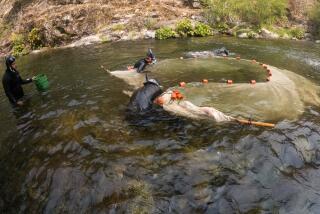Wild and Scenic Rivers Act: The Good, the Bad, the Beautiful : Ecology: Salmon and steelhead runs dwindle and the press of people continues to grow. Attention shifts to protecting entire watersheds.
- Share via
RAND, Ore. — George Bryan and his 8-year-old son, Jiggs, were preparing to use the Wild and Scenic Rivers Act--although to them, it was just a matter of taking their first trip down the famous Rogue River.
“I do a lot of rivers,” said Bryan, of Granite Falls, Wash. “It’s the only real, real camping left, but it’s the best there’s ever been.”
In some ways, that’s true. But not in all ways.
Thanks to the act passed 25 years ago, many rivers that might have been drowned by dams in the name of progress are flowing freely.
*
But as salmon and steelhead runs dwindle and the press of people continues to grow, those who would protect the Rogue and the rest of the nation’s premier waterways are finding there is more to keeping a river wild than the scenery.
“The Wild and Scenic Act is a great first step in terms of setting aside certain rivers that have mostly visual beauty,” said Paul Hoobyar, a river guide and staff member with the Pacific Rivers Council, an environmental group. “But in terms of saving the health of the river, it has proven to be not very effective.”
That’s why river advocates want to protect whole watersheds, said Kevin Coyle, vice president and conservation director of American Rivers in Washington, D.C.
“We need to go beyond the wild and scenic river system over the next 25 years, not only to fill out the system itself, but to figure out other ways to restore and protect rivers,” he said.
The Wild and Scenic Rivers Act was envisioned by John and Frank Craighead. As boys, the brothers canoed the Potomac River in Virginia. Later they did landmark research on grizzly bears in Yellowstone National Park.
After World War II, they became river pioneers, taking the rubber rafts once used by Navy fliers down rivers such as the Salmon in Idaho, known to the mountain men of the 19th Century as the River of No Return for its roaring rapids.
“We’d never see anybody at all on those early river floats. We rafted them when they were pretty wild,” said Frank Craighead, 77, from his home in Jackson Hole, Wyo.
Fresh from victory in World War II, the United States had a can-do attitude in the 1950s, and the U.S. Army Corps of Engineers drew up plans to harness hundreds of rivers across the country to control floods, produce hydroelectric power, and store irrigation water to make the desert bloom.
The Craigheads fought one dam after another and decided there had to be a better way.
*
They made a film of rafting the Salmon, wrote articles that appeared in National Geographic and other publications, and caught the wave of environmental concern generated by the Wilderness Act of 1964.
On Oct. 2, 1968, the Wild and Scenic Rivers Act was signed into law, protecting sections of eight rivers: the Middle Fork of the Clearwater and the Middle Fork of the Salmon in Idaho, the Eleven Point in Missouri, the Feather in California, the Rio Grande in New Mexico, the Rogue in Oregon, the St. Croix in Minnesota and Wisconsin and the Wolf in Wisconsin.
Since then, 144 pieces of river have been added, for a total of 10,000 miles of protected waterways, less than 1% of the nation’s river miles.
But, “You can’t just manage a narrow river corridor and ignore what happens upstream, downstream or side stream,” said Andy Kerr, conservation director of the Oregon Natural Resources Council in Portland. “Everything we do as humans basically ends up in the creek.”
The press of people is still the biggest threat to the Rogue, partly as a result of the attention it gets as a wild and scenic river, said Jerry MacLeod, district fish biologist for the Oregon Department of Fish and Wildlife.
Outside the wild and scenic corridor, the act can’t stem the flow of new residents to southern Oregon, many of them eager to build a house on the river and cut down the trees and willows along the bank to improve their view. That removes important shade that keeps water cool for fish, as well as allowing increased pollution from septic systems.
*
Environmentalists are still battling with the Army Corps of Engineers over completion of a dam that blocks access to salmon spawning grounds on Elk Creek, a Rogue tributary, and hope to see two old dams removed on the river.
“It has been less than 200 years since Lewis and Clark went through this country and anybody can see the changes,” John Craighead said from his home in Missoula, Mont. “If you go ahead another 100 or 200 years, the question is with the expanding populations and accompanying increased use of natural resources, will we be able to hold onto these things we set aside?”
More to Read
Sign up for Essential California
The most important California stories and recommendations in your inbox every morning.
You may occasionally receive promotional content from the Los Angeles Times.













